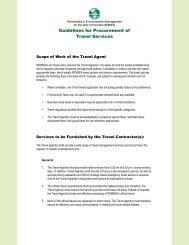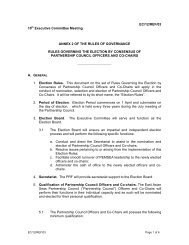Third East Asian Seas Youth Forum Toolkit - PEMSEA.org
Third East Asian Seas Youth Forum Toolkit - PEMSEA.org
Third East Asian Seas Youth Forum Toolkit - PEMSEA.org
- No tags were found...
Create successful ePaper yourself
Turn your PDF publications into a flip-book with our unique Google optimized e-Paper software.
<strong>Third</strong> <strong>East</strong> <strong>Asian</strong> <strong>Seas</strong> <strong>Youth</strong> <strong>Forum</strong>How to do it?REVIEWReviewing your project is really important for a few key reasons:• First, people who give you money – especially grants – will likely expect toknow what and how you did.• Second, you’ll be able to learn from your mistakes and adjust yourstrategies.• And third, you’ll find the simple process of doing a quick review after each projectmilestone ensures that ideas and any frustrations of team members are aired openly andcan be resolved!Don’t leave your review until the end – do quick reviews after each key milestone to learn as yougo. This doesn’t have to be complicated – just ask your team members for some quick feedback.At the end of your project, or perhaps at a specific point in the year you’ll want to do a morecomprehensive review.First, figure out what you’re evaluating. You’ll remember that in your SMART objectives, the M stood for Measurable. So you shouldalready have some sense of what it is you’re trying to measure and what would be an indicator of success. For example, if your objectivewas to hold 200 workshops across your country on climate change issues, an indicator of success would be the number of workshopsheld. Another indicator might be the percentage of participants who said they were happy with the workshop.Second, figure out how you can actually measure these results – what evidence is there? You could keep a logbook where you writedown the details of all the workshops you run. Or if there are no existing results you could conduct a survey of your participants to findout how they felt about the event.Once you know what you’re measuring and how you’re doing it – you can summarise your results and think about why you achievedwhat you did. If everything went according to plan, what contributed to that success? If some things were not as successful, what werethe reasons?Objective Indicator Actual Achievement Reason RecommendationOften, many of the most exciting results from a project can be unanticipated in your original plan – a surprise! This is notnecessarily a bad thing. Make sure your evaluation also considers results that helped achieve your objectives but were notoriginally identified in the indicators of success. And there may be some exciting results that achieved much good but were noteven related to your original objectives. When you have surprising results, think about why it happened. Next time, you mightwant to actually aim for a repeat experience. Or you might still want to figure out how you can avoid them because they were notcentral to your overall mission.34














